Optimization and Application of Bioflocculant Passivated Copper Nanoparticles in the Wastewater Treatment
Abstract
1. Introduction
2. Materials and Methods
2.1. Synthesis of Copper Nanoparticles
2.2. Characterization of As-Synthesized Copper Nanoparticles
2.3. Test for Flocculation Activity of Copper Nanoparticles
2.4. Optimization of Copper Nanoparticles in Flocculation Activity
2.5. Removal Efficiency of Dyes by Copper Nanoparticles
2.6. Application of Nanoparticles in the Treatment of Wastewater
2.7. Antimicrobial Activity Test for Synthesized Nanoparticles
2.7.1. Minimum Inhibitory Concentration (MIC)
2.7.2. Minimum Bactericidal Concentration (MBC)
3. Results and Discussion
3.1. Characterization Results of Purified Bioflocculant and As-Synthesized Copper Nanoparticles
3.2. Effect of Dosage on Flocculation Activity of Nanoparticles
3.3. The Effect of pH on Flocculation Activity of Copper Nanoparticles
3.4. The Effect of Cations on Flocculation Activity of Copper Nanoparticles
3.5. The Temperature Effect on Flocculation Activity of Copper Nanoparticles
3.6. The Effect of Shaking Speed on Flocculation Activity of Copper Nanoparticles
3.7. The Effect of Copper Nanoparticles on Staining Dye Removal
3.8. Removal Efficiency of Pollutants in Wastewater
3.9. Minimal Inhibitory Concentration, Minimal Bactericidal Concentration in mg/mL for Copper Nanoparticles
4. Conclusions
Author Contributions
Funding
Acknowledgments
Conflicts of Interest
References
- Naidoo, S.; Olaniran, A. Treated wastewater effluent as a source of microbial pollution of surface water resources. Int. J. Environ. Res. Public Health 2014, 11, 249–270. [Google Scholar] [CrossRef] [PubMed]
- Yue, Q.Y.; Gao, B.Y.; Wang, Y.; Zhang, H.; Sun, X.; Wang, S.G.; Gu, R.R. Synthesis of polyamine flocculants and their potential use in treating dye wastewater. J. Hazard. Mater. 2008, 152, 221–227. [Google Scholar] [CrossRef] [PubMed]
- Renault, F.; Sancey, B.; Badot, P.; Crini, C. Chitosan for coagulation/flocculation processes—An eco-friendly approach. Eur. Polym. J. 2009, 45, 1337–1348. [Google Scholar] [CrossRef]
- Ma, J.; Shi, J.; Ding, L.; Zhang, H.; Zhou, S.; Wang, Q.; Fu, X.; Jiang, L.; Fu, K. Removal of emulsified oil from water using hydrophobic modified cationic polyacrylamide flocculants synthesized from low-pressure UV initiation. Sep. Purif. Technol. 2018, 197, 407–417. [Google Scholar] [CrossRef]
- Kumar, M.; Puri, A. A review of permissible limits of drinking water. Indian J. Occup. Environ. Med. 2012, 16, 40. [Google Scholar]
- Davis, A.P.; Shokouhian, M.; Sharma, H.; Minami, C. Water quality improvement through bioretention media: Nitrogen and phosphorus removal. Water Environ. Res. 2006, 78, 284–293. [Google Scholar] [CrossRef]
- Agrawal, A.; Sahu, K.; Pandey, B. Solid waste management in non-ferrous industries in India. Resour. Conserv. Recycl. 2004, 42, 99–120. [Google Scholar] [CrossRef]
- Okaiyeto, K.; Nwodo, U.U.; Okoli, S.A.; Mabinya, L.V.; Okoh, A.I. Implications for public health demands alternatives to inorganic and synthetic flocculants: Bioflocculants as important candidates. Microbiol. Open 2016, 5, 177–211. [Google Scholar] [CrossRef]
- Ugbenyen, A.; Okoh, A. Characteristics of a bioflocculant produced by a consortium of Cobetia and Bacillus species and its application in the treatment of wastewaters. Water SA 2014, 40, 140–144. [Google Scholar] [CrossRef]
- Thakur, V.; Singha, A.; Thakur, M. Surface modification of natural polymers to impart low water absorbency. Int. J. Polym. Anal. Charact. 2012, 17, 133–143. [Google Scholar] [CrossRef]
- Zhang, C.-L.; Cui, Y.-N.; Wang, Y. Bioflocculant produced from bacteria for decolorization, Cr removal and swine wastewater application. Sustain. Environ. Res. 2012, 22, 129–134. [Google Scholar]
- Gharge, V.G.; Gore, M.M. and Yadav, A. Different techniques for preparation of nanoemulsion with characterisation and various application of it—A review. World J. Pharm. Res. 2017, 15, 112–128. [Google Scholar] [CrossRef]
- Kanhed, P.; Birla, S.; Gaikwad, S.; Gade, A.; Seabra, A.B.; Rubilar, O.; Duran, N.; Rai, M. In vitro antifungal efficacy of copper nanoparticles against selected crop pathogenic fungi. Mater. Lett. 2014, 115, 13–17. [Google Scholar] [CrossRef]
- Sathiyanarayanan, G.; Kiran, G.S.; Selvin, J. Synthesis of silver nanoparticles by polysaccharide bioflocculant produced from marine Bacillus subtilis MSBN17. Colloids Surf. B Biointerfaces 2013, 102, 13–20. [Google Scholar] [CrossRef]
- Dlamini, N.G.; Basson, A.K.; Pullabhotla, V.S.R.R. Biosynthesis and characterization of copper nanoparticles using a bioflocculant extracted from Alcaligenes faecalis HCB2. Adv. Sci. Eng. Med. 2019, 11, 1–7. [Google Scholar] [CrossRef]
- Xia, X.; Lan, S.; Li, X.; Xie, Y.; Liang, Y.; Yan, P.; Chen, Z.; Xing, Y. Characterization and coagulation-flocculation performance of a composite flocculant in high-turbidity drinking watertreatment. Chemosphere 2018, 206, 701–708. [Google Scholar] [CrossRef]
- Agunbiade, M.; Pohl, C.; Ashafa, O. Bioflocculant production from Streptomyces platensis and its potential for river and waste water treatment. Br. J. Microbiol. 2018. [Google Scholar] [CrossRef]
- Buthelezi, S.P.; Olaniran, A.O.; Pillay, B. Textile dye removal from wastewater effluents using bioflocculants produced by indigenous bacterial isolates. Molecules 2012, 17, 14260–14274. [Google Scholar] [CrossRef]
- Maliehe, S.; Shandu, S.J.; Basson, K.A. The antibacterial and antidiarreal activities of the crude methanolic Syzygium cordatum [S. Ncik, 48 (UZ)] fruit pulp and seed extracts. J. Med. Plants Res. 2015, 9, 884–891. [Google Scholar] [CrossRef]
- Eloff, J.N. A sensitive and quick microplate method to determine the minimal inhibitory concentration of plant extracts for bacteria. Planta Med. 1998, 64, 711–713. [Google Scholar] [CrossRef]
- Peng, L.; Yang, C.; Zeng, G.; Wang, L.; Dai, C.; Long, Z.; Liu, H.; Zhong, Y. Characterization and application of bioflocculant prepared by Rhodococcus erythropolis using sludge and livestock wastewater as cheap culture media. Appl. Microbiol. Biotechnol. 2014, 98, 6847–6858. [Google Scholar] [CrossRef]
- Gao, J.; Bao, H.Y.; Xin, M.X.; Liu, Y.X.; Li, Q.; Zhang, Y.F. Characterization of a bioflocculant from a newly isolated Vagococcus sp. W31. J. Zhejiang Univ. Sci. B 2006, 7, 186–192. [Google Scholar] [CrossRef]
- Gong, W.-X.; Wang, S.-G.; Sun, X.-F.; Liu, X.-W.; Yue, Q.-Y.; Gao, B.-Y. Bioflocculant production by culture of Serratia ficaria and its application in wastewater treatment. Bioresour. Technol. 2008, 99, 4668–4674. [Google Scholar] [CrossRef]
- Zaki, S.A.; Elkady, M.F.; Farag, S.; Abd-El-Haleem, D. Characterization and flocculation properties of a carbohydrate bioflocculant from a newly isolated Bacillus velezensis 40B. J. Environ. Biol. 2013, 34, 51. [Google Scholar]
- Wang, L.; Ma, F.; Qu, Y.; Sun, D.; Li, A.; Guo, J.; Yu, B. Characterization of a compound bioflocculant produced by mixed culture of Rhizobium radiobacter F2 and Bacillus sphaeicus F6. World J. Microbiol. Biotechnol. 2011, 27, 2559–2565. [Google Scholar] [CrossRef]
- Yu-sen, E.L.; Vidic, R.D.; Stout, J.E.; Victory, L.Y. Negative effect of high pH on biocidal efficacy of copper and silver ions in controlling Legionella pneumophila. Appl. Environ. Microbiol. 2002, 68, 2711–2715. [Google Scholar]
- Li, Y.; Xu, Y.; Liu, L.; Jiang, X.; Zhang, K.; Zheng, T.; Wang, H. First evidence of bioflocculant from Shinella albus with flocculation activity on harvesting of Chlorella vulgaris biomass. Bioresour. Technol. 2016, 218, 807–815. [Google Scholar] [CrossRef]
- Liu, W.; Wang, K.; Li, B.; Yuan, H.; Yang, J. Production and characterization of an intracellular bioflocculant by Chryseobacterium daeguense W6 cultured in low nutrition medium. Bioresour. Technol. 2010, 101, 1044–1048. [Google Scholar] [CrossRef]
- Aljuboori, A.H.R.; Idris, A.; Al-joubory, H.H.R.; Uemura, Y.; Abubakar, B.I. Flocculation behavior and mechanism of bioflocculant produced by Aspergillus flavus. J. Environ. Manag. 2015, 150, 466–471. [Google Scholar] [CrossRef]
- Sun, J.; Zhang, X.; Miao, X.; Zhou, J. Preparation and characteristics of bioflocculants from excess biological sludge. Bioresour. Technol. 2012, 126, 362–366. [Google Scholar] [CrossRef]
- Salehizadeh, H.; Shojaosadati, S. Extracellular biopolymeric flocculants: Recent trends and biotechnological importance. Biotechnol. Adv. 2001, 19, 371–385. [Google Scholar] [CrossRef]
- Deng, S.; Yu, G.; Ting, Y.P. Production of a bioflocculant by Aspergillus parasiticus and its application in dye removal. Colloids Surf. B Biointerfaces 2005, 44, 179–186. [Google Scholar] [CrossRef]
- Tiwary, R. Environmental impact of coal mining on water regime and its management. Water Air Soil Pollut. 2001, 132, 185–199. [Google Scholar] [CrossRef]
- Gao, C.; Zhu, J.; Zhu, J.; Gao, X.; Dou, Y.; Hosen, Y. Nitrogen export from an agriculture watershed in the Taihu Lake area, China. Environ. Geochem. Health 2004, 26, 199–207. [Google Scholar] [CrossRef]

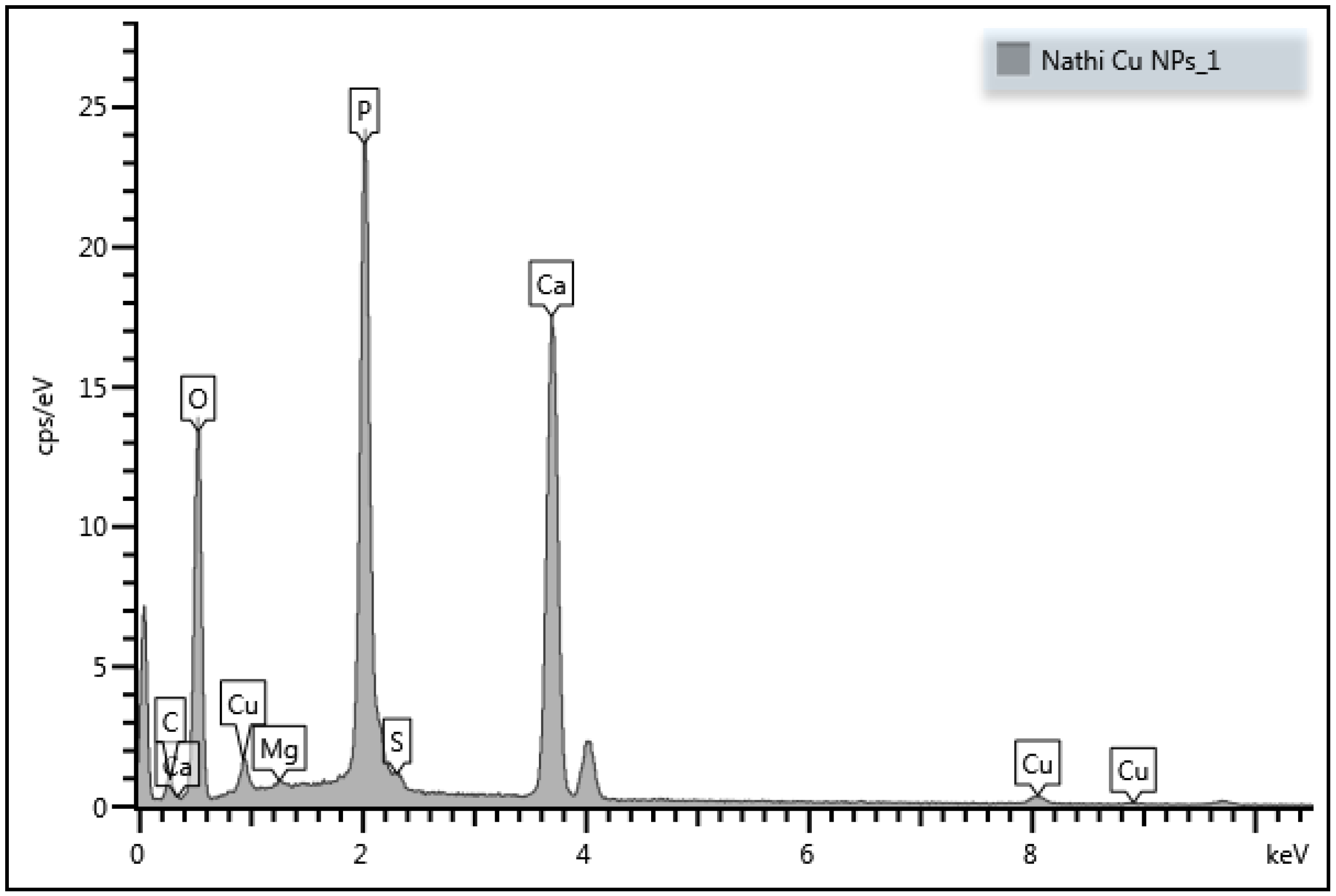
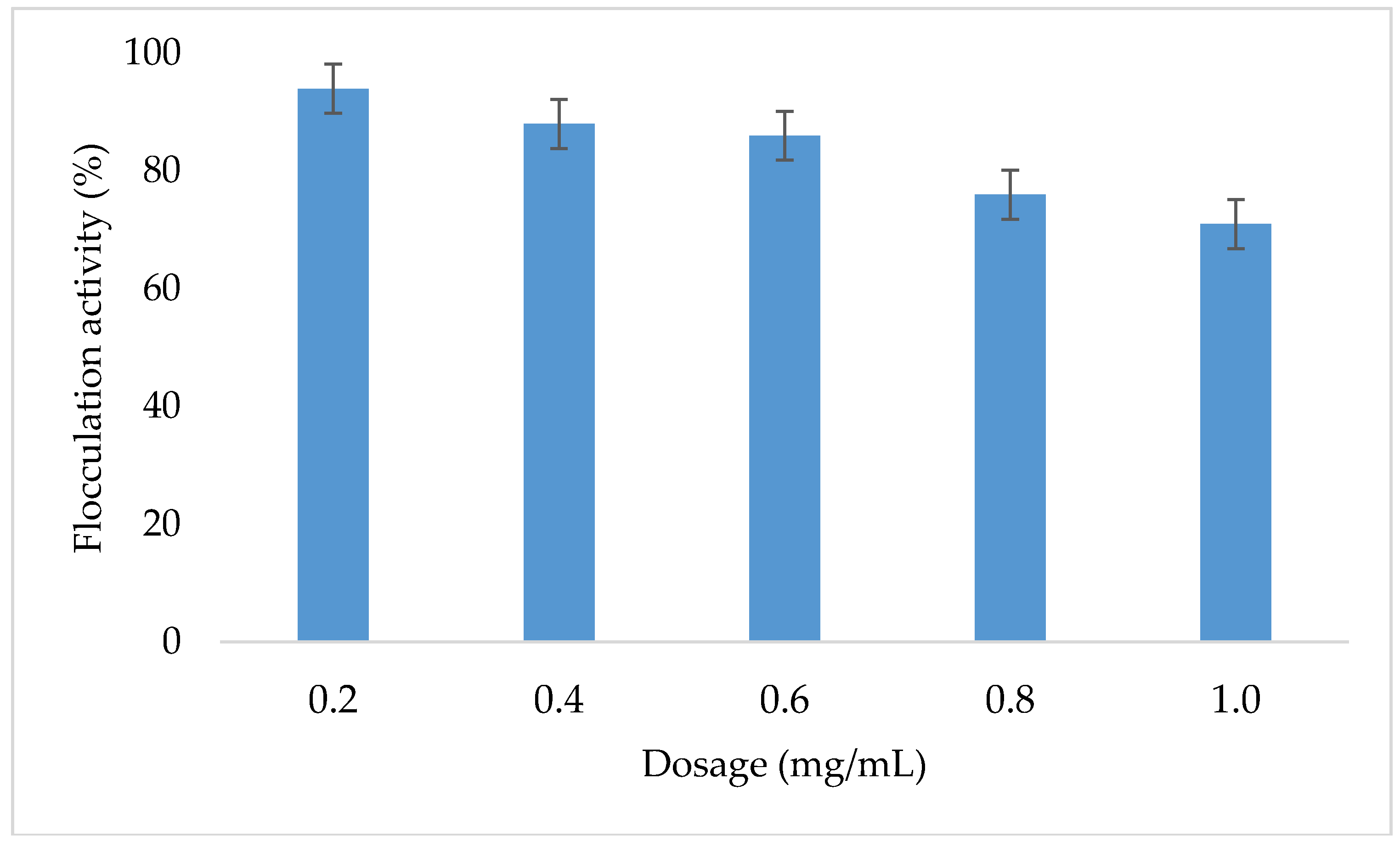
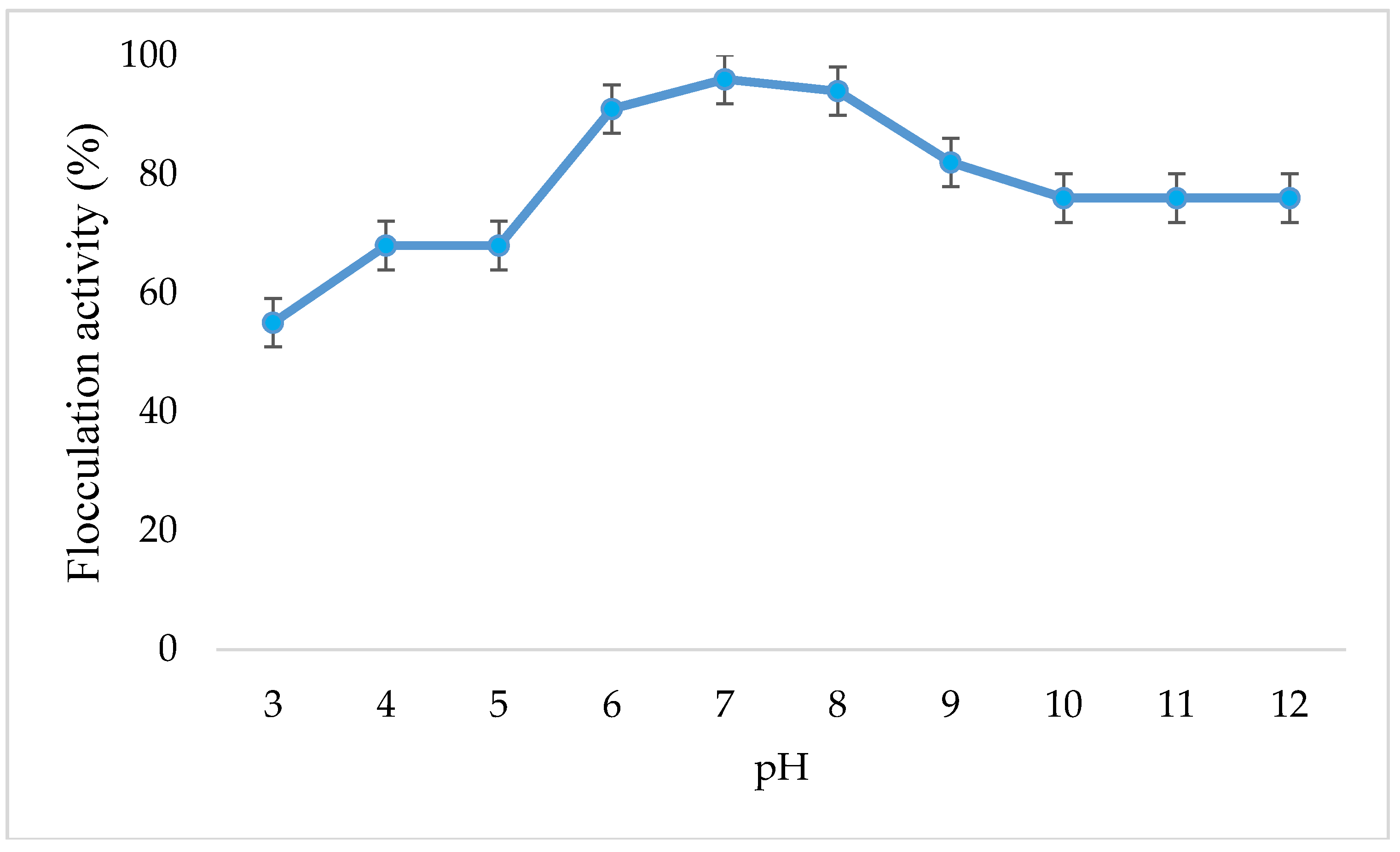
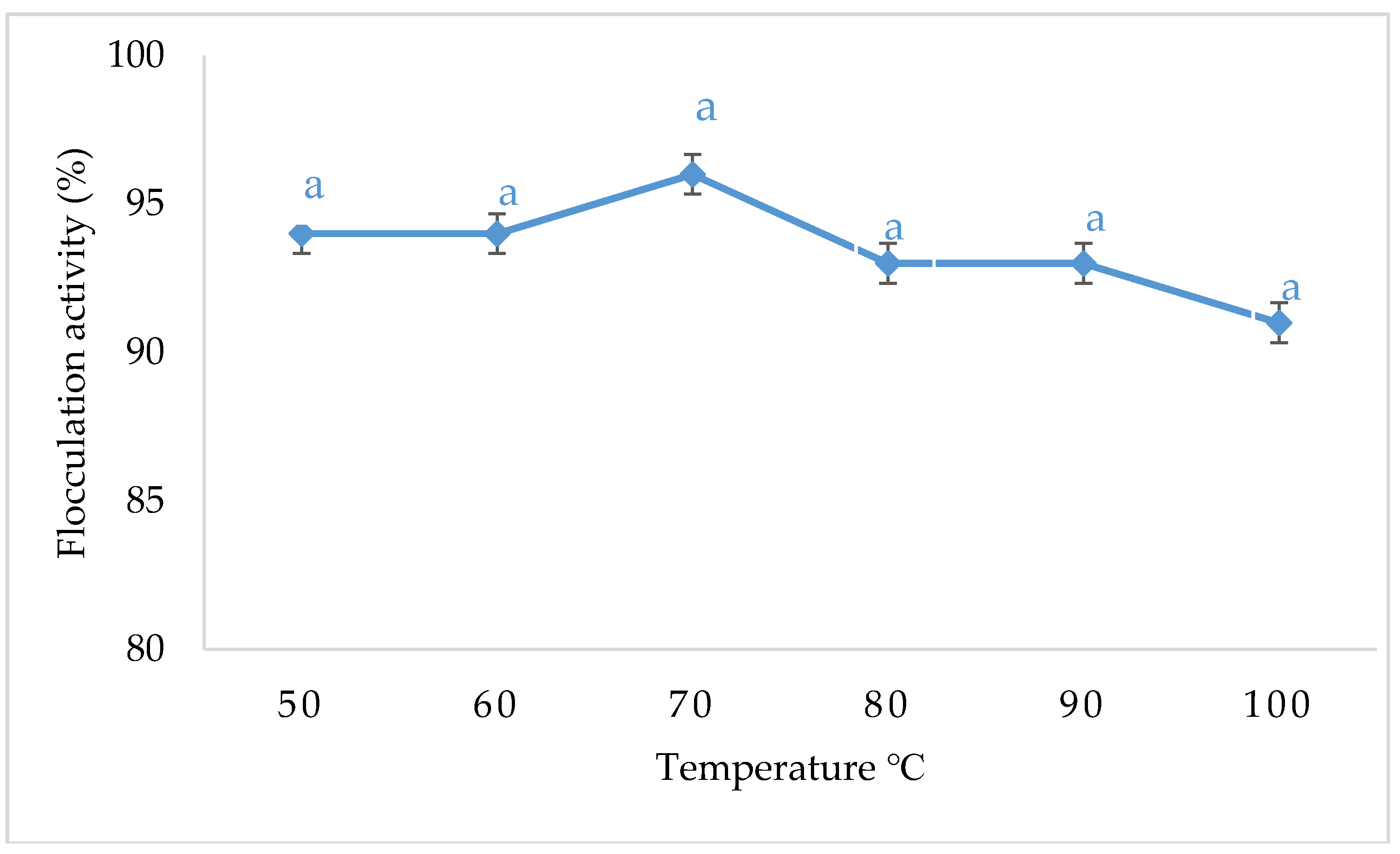
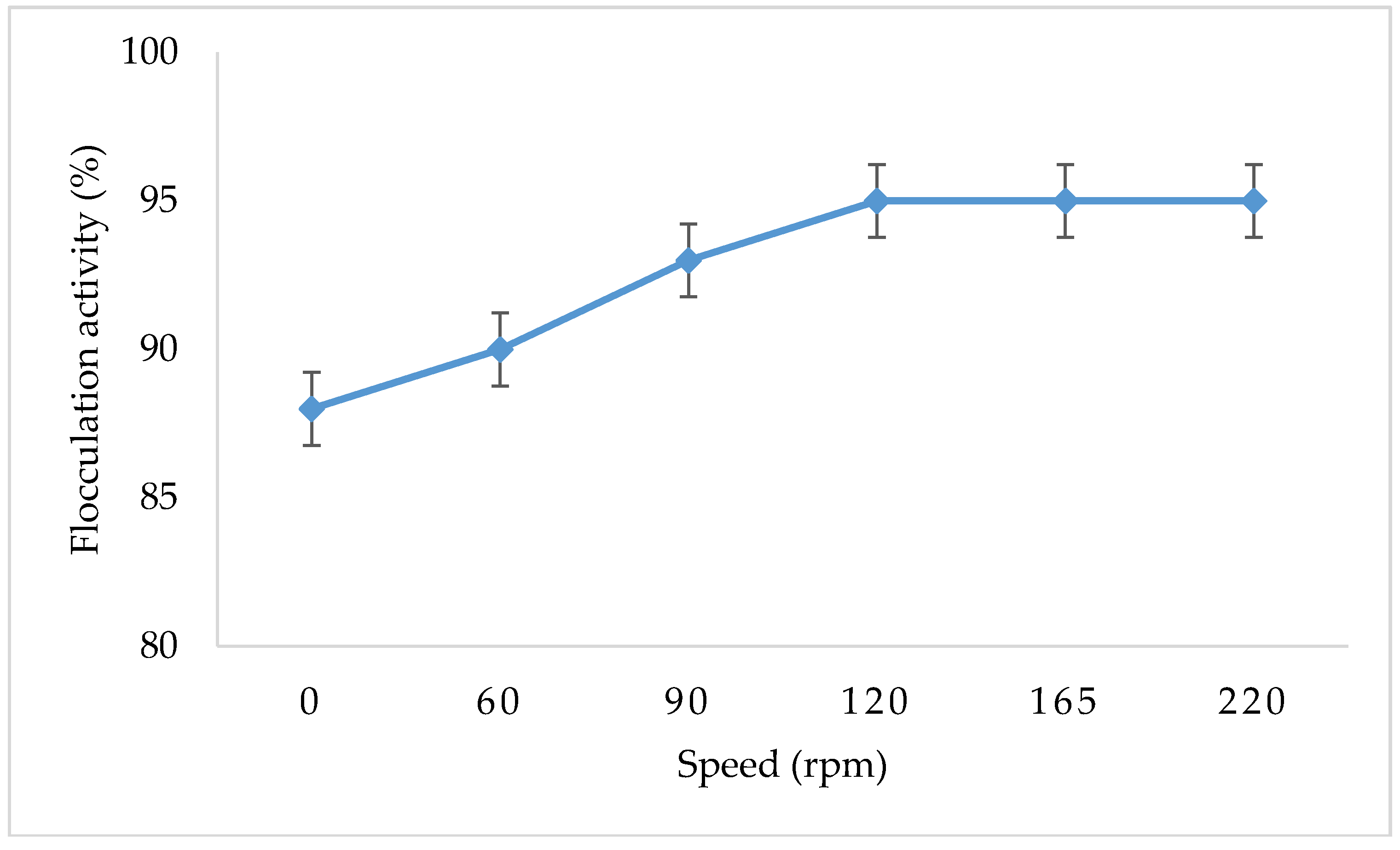
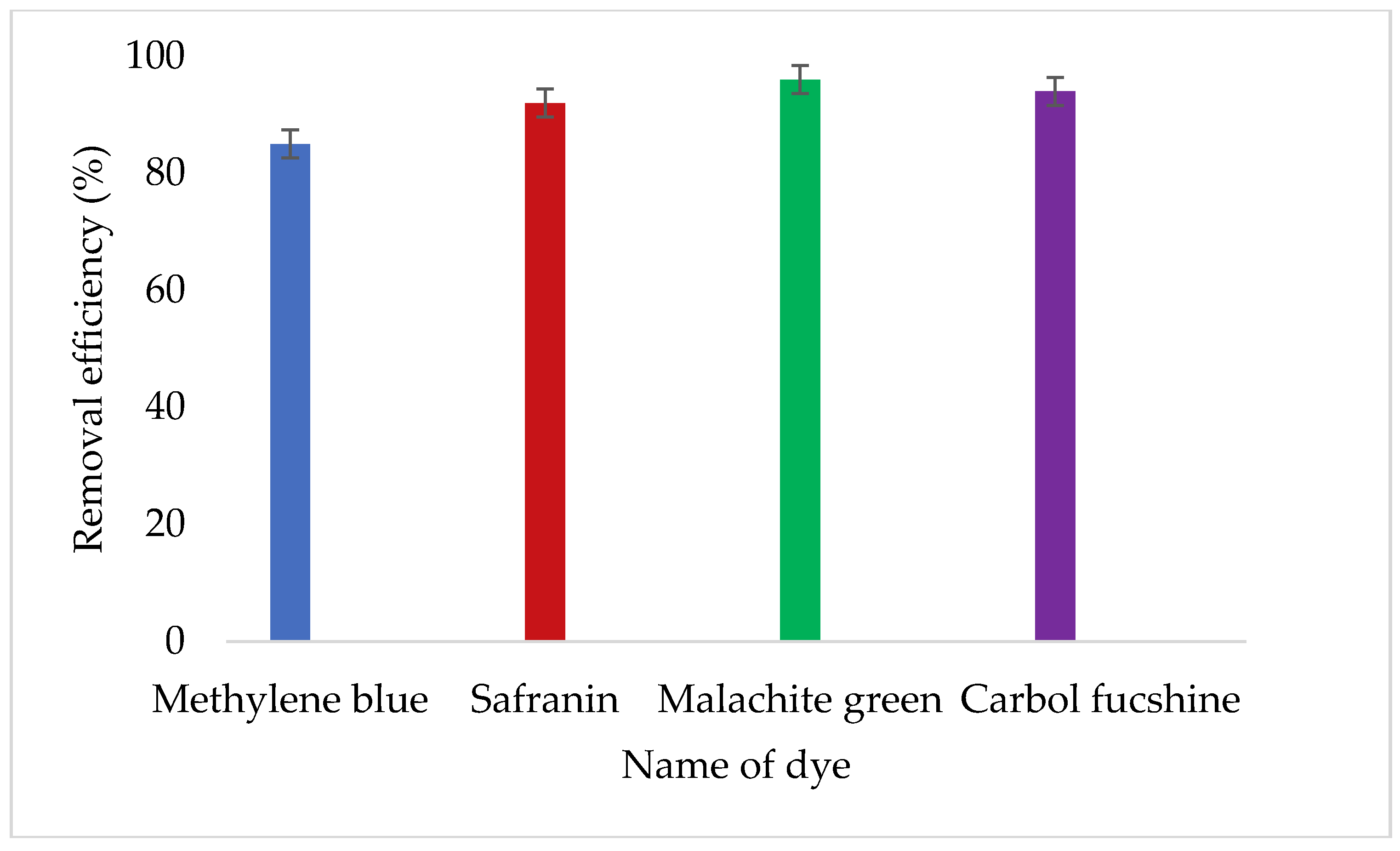
| Cations | Flocculation Activity (%) ± SD |
|---|---|
| Control Fe3+ Mn2+ Ba2+ K+ Li+ Na+ | 96 ± 2.08 86 ± 3.74 97 ± 1.52 95 ± 3.46 96 ± 2.88 97 ± 1.15 86 ± 1.15 |
| Flocculant | Types of Wastewater | Types of Pollutants in Water | Water Quality before Treatment (mg/L) | Water Quality after Treatment (mg/L) | Removal Efficiency (%) |
|---|---|---|---|---|---|
| CuNPs | Coal mine water | Phosphate Sulphate Chemical oxygen demand (COD) Biochemical oxygen demand (BOD) | 2.00 0.55 154 123.2 | 0.3 0.13 11.2 5.0 | 85 76 93 96 |
| Domestic wastewater | Phosphate Total nitrogen Nitrate Aluminum Sulphate Chemical oxygen demand (COD) Biochemical oxygen demand (BOD) | 7.6 155 20.6 0.86 1.7 2.313 123.2 | 1.5 17.0 7.7 0.33 0.61 0.654 4.123 | 80 89 63 62 64 72 96 | |
| Mzingazi River water | Phosphate Total nitrogen Chemical oxygen demand (COD) Biochemical oxygen demand (BOD) | 85.7 0.223 3.300 133 | 7.521 0.108 0.278 15.0 | 92 52 92 89 |
| Strains of Bacteria | Ciprofloxacin | CuNPs | ||
|---|---|---|---|---|
| Minimal Inhibitory Concentration (MIC) | Minimal Bactericidal Concentration (MBC) | Minimal Inhibitory Concentration (MIC) | Minimal Bactericidal Concentration (MBC) | |
| B. pumilus | - | - | 3.13 | 6.25 |
| E. coli | 3.125 | 6.25 | 6.25 | 12.5 |
| C. freundii | 1.56 | 3.13 | 12.5 | 12.5 |
| K. pneumoniae | 1.56 | 3.13 | 12.5 | 25.0 |
© 2019 by the authors. Licensee MDPI, Basel, Switzerland. This article is an open access article distributed under the terms and conditions of the Creative Commons Attribution (CC BY) license (http://creativecommons.org/licenses/by/4.0/).
Share and Cite
Dlamini, N.G.; Basson, A.K.; Pullabhotla, V.S.R. Optimization and Application of Bioflocculant Passivated Copper Nanoparticles in the Wastewater Treatment. Int. J. Environ. Res. Public Health 2019, 16, 2185. https://doi.org/10.3390/ijerph16122185
Dlamini NG, Basson AK, Pullabhotla VSR. Optimization and Application of Bioflocculant Passivated Copper Nanoparticles in the Wastewater Treatment. International Journal of Environmental Research and Public Health. 2019; 16(12):2185. https://doi.org/10.3390/ijerph16122185
Chicago/Turabian StyleDlamini, Nkosinathi Goodman, Albertus Kotze Basson, and Viswanadha Srirama Rajasekhar Pullabhotla. 2019. "Optimization and Application of Bioflocculant Passivated Copper Nanoparticles in the Wastewater Treatment" International Journal of Environmental Research and Public Health 16, no. 12: 2185. https://doi.org/10.3390/ijerph16122185
APA StyleDlamini, N. G., Basson, A. K., & Pullabhotla, V. S. R. (2019). Optimization and Application of Bioflocculant Passivated Copper Nanoparticles in the Wastewater Treatment. International Journal of Environmental Research and Public Health, 16(12), 2185. https://doi.org/10.3390/ijerph16122185






